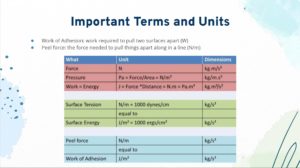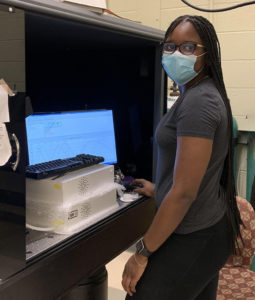Sticking Together: Adhesion and How it Works
Kimberlie Dupiton
August 2021
Summary
This project targets STEM education in the pre-college setting on the topic of adhesion, which is directly correlated with some of the concepts that I needed to learn for my research lab. This activity targets first-year high school students in Florence, Italy and Philadelphia, PA since they are sister cities. These students would be given the task to compare different sticky tapes to develop a deeper understanding of adhesion. Students will find similarities and differences in the adhesion force data that they complete for the different tapes and brainstorm reasons for the irregularities in the data and ways to create consistency in the data globally. This activity would be completed to demonstrate different adhesion properties between materials and why adhesion is important in our everyday lives.
Sample of Lesson Plan Materials

Presentation for Students
Videos used in Student Presentation
S. Lopez Explains how Geckos have Inspired Polymer Scientists at The University of Akron
How to make a Sticky Tape Testing Apparatus
Lesson Plan for Teachers
Sample Data Submission Form Questions
Brief Overview of Research that stimulated this project
My research is on multi-functional polymer nanocomposite coatings with strong glass adhesion properties. The purpose of this research is to investigate which solutions have the best binding results for hydrophobic polymer adhesion with glass to make durable coatings. We tested nanoparticle size and sintering conditions’ effects on the adhesion of nanoparticles to glass. In order to make polymer-infiltrated nanoparticle films, a method called capillary rise infiltration (CaRI) was used. CaRI is a method of making polymer nanocomposite films with ultra-high NP loadings.
Bio
Kimberlie Dupiton is a senior at the University of Pennsylvania studying Psychology and Chemistry. She joined the Fakhraai lab in Fall 2019, where she has worked on multi-functional polymer nanocomposite coatings.
References & Acknowledgements
References
Note: Idea developed from The University of Akron
- Cooper, Sean. “Failure Modes: Practical Adhesion Science: Prof Steven Abbott.” Failure Modes, Practical Adhesion Science, Prof Steven Abbott, www.stevenabbott.co.uk/practical-adhesion/fmodes.php.
- Cooper, Sean. “Why Does Stuff Stick?: Practical Adhesion Science: Prof Steven Abbott.” Why Does Stuff Stick?, Practical Adhesion Science, Prof Steven Abbott, www.stevenabbott.co.uk/practical-adhesion/basics.php.
- The University of Akron, Ohio. “Adhesives How Sticky Is Your Tape.” The University of Akron, Ohio, 24 Oct. 2016, www.uakron.edu/polymer/agpa-k12outreach/lesson-plans/adhesives-how-sticky-is-your-tape.
Acknowledgements
I thank Prof. Baumgart’s group for the plasma cleaner and the Fakhraai group members especially Yueli Chen, Haonan Wang, and Tolu Lawal.
I also thank Kristin Field and the REACT Program for funding and programs. This work was supported by the National Science Foundation Partnerships in International Research and Education Funding (Award #1545884).

